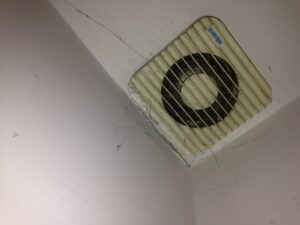The bathroom exhaust fans in your home are some of the most used parts of your ventilation system. Not only do they effectively eliminate odors from the room, but they also help remove heat and excess moisture. It also helps keep your bathroom mirror clear after a shower for last-minute touch-ups before heading out for the day.
Without that fan, excess moisture can build on the walls, leading to streaky paint, mold and mildew, and other issues. The problems can be compounded if the ventilating fan leads to the attic and the ductwork is failing or non-existent. A fleck of mold in your shower is easily spotted. In your attic? Not so much.
In order to install a bathroom fan, you need to be relatively handy. You’ll be dealing with electrical lines as well as the roof structure if you have a single-level house. If the bathroom is in the basement or needs to be vented through a wall, things can be even trickier.
In most cases, if you need to install a bathroom fan from square one, it’s best to leave it to the professionals. There are just too many things that can go wrong, especially if you have to cut a hole in the roof, wall, or foundation (for basement fans). Some things to consider:
Cut a hole to fit the fan
If this is a new fan, you’ll need to cut a hole in the ceiling of the bathroom. Before you cut, it’s best to mark the location of your fan by inserting roofing nails into the drywall at each corner of the fan. You want to make sure the nails extend into the attic so you can find the nails and note the location with a pencil. Next, cut the plaster or drywall with a saw.
Attach the fan and cut a hole in the roof
Now, you’ll need to attach the fan with screws. Don’t forget to leave a six-inch gap between the fan and any insulation. Next, mark the underpart of the roof with a pencil, ensuring you leave room for the roof vent and tailpipe.
Using a drill, make a hole large enough for a saw blade, then cut the circle with the saw. Remove any shingles from the area, making sure you do not damage the roof paper underlayment. You may need flexible ducting if roof trusses are in the way. Just try to make sure the water vapor can escape over the shortest possible distance.
Install the roof vent
Slide the top flange of the roof vent under the shingles, then put the bottom flange below. To seal, add roof adhesive on the underside of the flanges, then nail the flanges before putting the roof shingles on. Make sure the shingles are sealed properly with roofing cement, so no moisture gets in to cause damage or dry rot.
Wire the fan and switch
Turn the circuit breaker off before you start any electrical work. Connect wiring according to the package directions, including the green ground wires, and ensure that the fan motor is plugged into the unit. Once connected, turn the circuit breaker back on and test the fan to make sure everything is operational.
Too much steam in the bathroom can be an issue. But if you don’t properly seal a roof vent, run the ducting, or tie into the existing power source, you could be facing some really big problems. Not to mention many of these steps must meet building codes.
Replacing A Bathroom Exhaust Fan
Replacing a bathroom ceiling fan unit is much easier because most of the infrastructure is in place. Still, you need to be somewhat knowledgeable of how wiring works and be able to work overhead. You may need to replace the fan housing if the new fan doesn’t align with the old fan.
Maybe your fan isn’t strong enough to remove the steam, you don’t like the fan light, or it has just reached the end of its lifespan. If you’re comfortable with replacing a light fixture, you may be able to change out an exhaust fan. Just make sure you follow all Original Equipment Manufacturer’s instructions.
It’s important to choose the right size fan for the bathroom you’re putting it in, too. Small fans can ventilate a space for 79 square feet or less, while medium fans are best for 70 to 100 square foot areas. For larger areas, you’ll need a large fan to effectively circulate the air.
Call in the professionals
Although matching up black wires to black wires and white wires to white wires may sound simple, one false move can spell disaster. Once you start cutting into the structure of a wall, ceiling, or roof, those problems can grow exponentially. If this is your first foray into home improvement, consider calling Prairie Electric.
For more than 35 years, we’ve been installing bathroom exhaust fans, replacing residential and commercial electrical panels, and fabricating custom automation panels for industrial applications. No job is too big or too small for Prairie Electric. So if you have questions about your bathroom fan and aren’t sure how to wire it, we can help! Contact our experienced team at Prairie Electric today.


